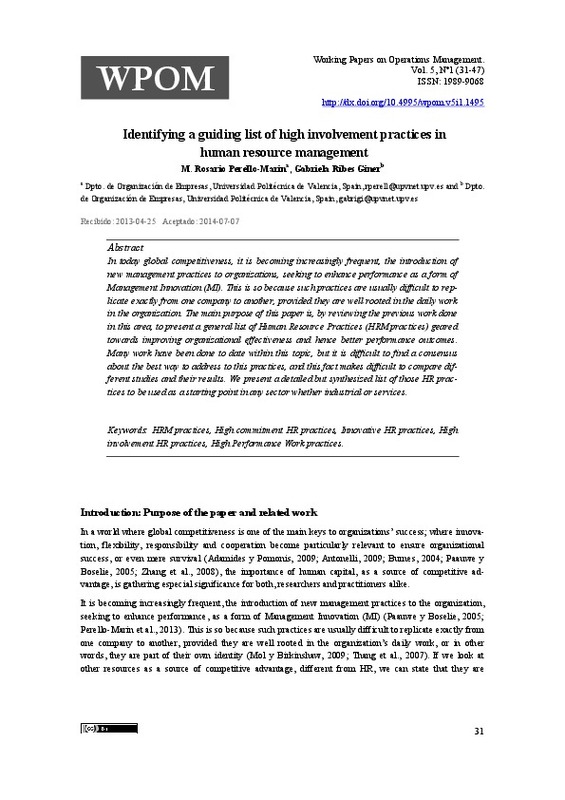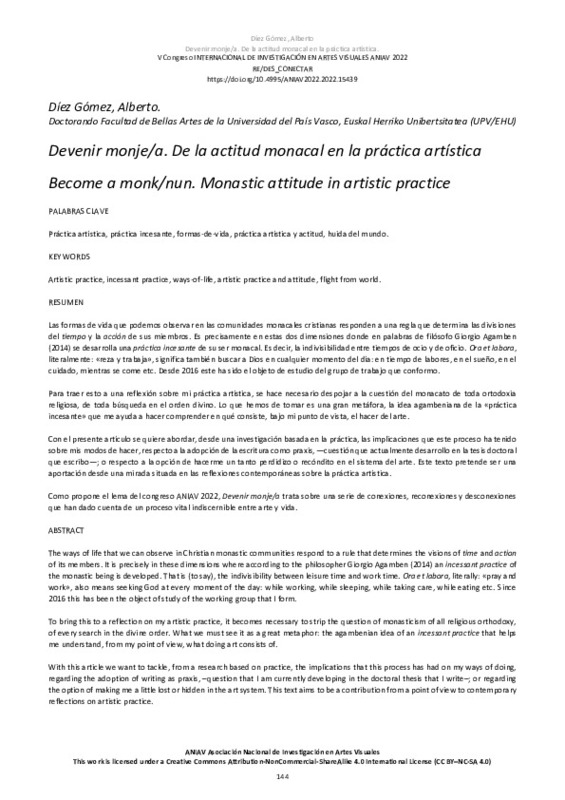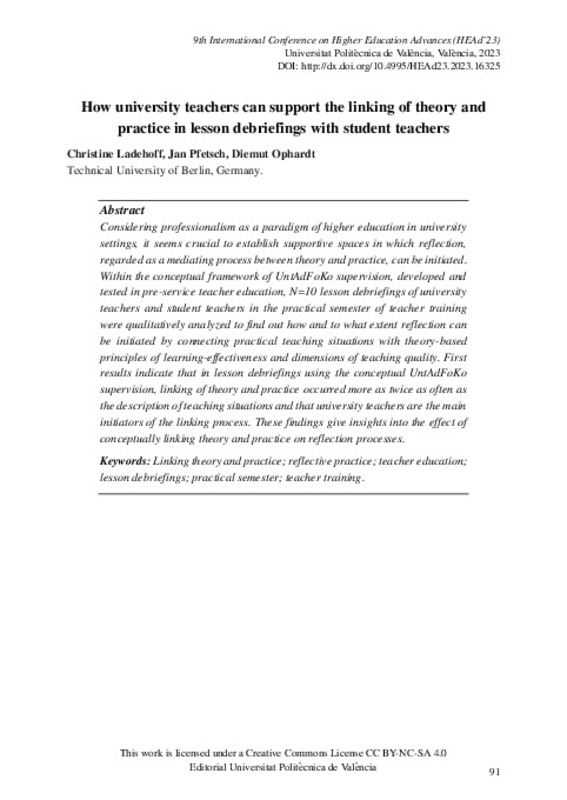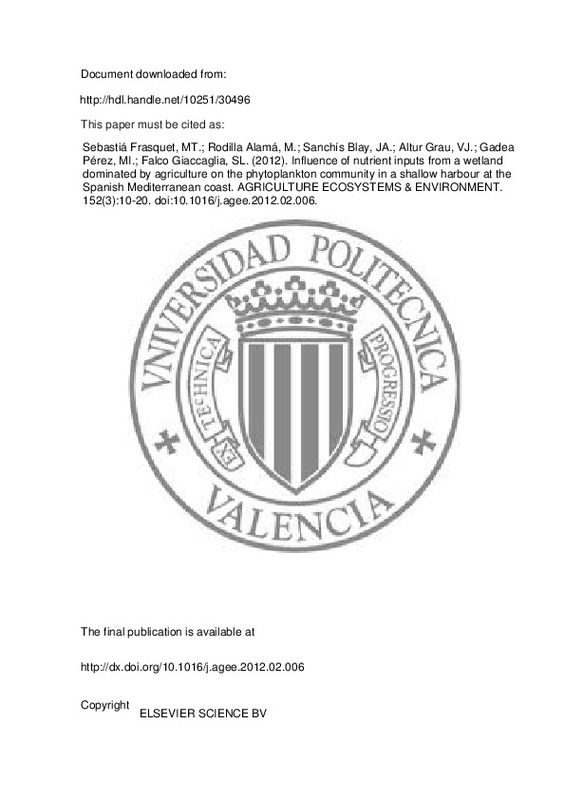Adamides, E. D., & Pomonis, N. (2009). The co-evolution of product, production and supply chain decisions, and the emergence of manufacturing strategy. International Journal of Production Economics, 121(2), 301-312. doi:10.1016/j.ijpe.2006.11.025
Ahmad, S., & Schroeder, R. G. (2002). The impact of human resource management practices on operational performance: recognizing country and industry differences. Journal of Operations Management, 21(1), 19-43. doi:10.1016/s0272-6963(02)00056-6
Alfes, K., Shantz, A. D., Truss, C., & Soane, E. C. (2013). The link between perceived human resource management practices, engagement and employee behaviour: a moderated mediation model. The International Journal of Human Resource Management, 24(2), 330-351. doi:10.1080/09585192.2012.679950
[+]
Adamides, E. D., & Pomonis, N. (2009). The co-evolution of product, production and supply chain decisions, and the emergence of manufacturing strategy. International Journal of Production Economics, 121(2), 301-312. doi:10.1016/j.ijpe.2006.11.025
Ahmad, S., & Schroeder, R. G. (2002). The impact of human resource management practices on operational performance: recognizing country and industry differences. Journal of Operations Management, 21(1), 19-43. doi:10.1016/s0272-6963(02)00056-6
Alfes, K., Shantz, A. D., Truss, C., & Soane, E. C. (2013). The link between perceived human resource management practices, engagement and employee behaviour: a moderated mediation model. The International Journal of Human Resource Management, 24(2), 330-351. doi:10.1080/09585192.2012.679950
Altinay, L., Altinay, E., & Gannon, J. (2008). Exploring the relationship between the human resource management practices and growth in small service firms. The Service Industries Journal, 28(7), 919-937. doi:10.1080/02642060701846804
Anand, G., & Kodali, R. (2008). Selection of lean manufacturing systems using the PROMETHEE. Journal of Modelling in Management, 3(1), 40-70. doi:10.1108/17465660810860372
Antonelli, C. (2009). The economics of innovation: from the classical legacies to the economics of complexity. Economics of Innovation and New Technology, 18(7), 611-646. doi:10.1080/10438590802564543
Arthur, J. B. (1994). EFFECTS OF HUMAN RESOURCE SYSTEMS ON MANUFACTURING PERFORMANCE AND TURNOVER. Academy of Management Journal, 37(3), 670-687. doi:10.2307/256705
Arthur, J. B., & Boyles, T. (2007). Validating the human resource system structure: A levels-based strategic HRM approach. Human Resource Management Review, 17(1), 77-92. doi:10.1016/j.hrmr.2007.02.001
Avella, L., Fernández, E., & Vázquez, C. J. (2001). Analysis of manufacturing strategy as an explanatory factor of competitiveness in the large Spanish industrial firm. International Journal of Production Economics, 72(2), 139-157. doi:10.1016/s0925-5273(00)00099-2
Barrett, R., & Mayson, S. (2007). Human resource management in growing small firms. Journal of Small Business and Enterprise Development, 14(2), 307-320. doi:10.1108/14626000710746727
Bayo Moriones, A.; Merino Díaz de Cerio, J. (2002). Las prácticas de recursos humanos de alto compromiso: un estudio de los factores que influyen sobre su adopción en la industria espa-ola. Cuadernos de Economía y Dirección de la Empresa nº. 12, pp. 227-247.
Bayo‐Moriones, A., Bello‐Pintado, A., & Merino‐Díaz‐de‐Cerio, J. (2008). The role of organizational context and infrastructure practices in JIT implementation. International Journal of Operations & Production Management, 28(11), 1042-1066. doi:10.1108/01443570810910188
BECKER, B., & GERHART, B. (1996). THE IMPACT OF HUMAN RESOURCE MANAGEMENT ON ORGANIZATIONAL PERFORMANCE: PROGRESS AND PROSPECTS. Academy of Management Journal, 39(4), 779-801. doi:10.2307/256712
Benson, G. S., Young, S. M., & Lawler III, E. E. (2006). High-involvement work practices and analysts’ forecasts of corporate earnings. Human Resource Management, 45(4), 519-537. doi:10.1002/hrm.20130
Boselie, P., Dietz, G., & Boon, C. (2005). Commonalities and contradictions in HRM and performance research. Human Resource Management Journal, 15(3), 67-94. doi:10.1111/j.1748-8583.2005.tb00154.x
Bowen, D. E.; Ostroff, C. (2004). Understanding HRN–firm performance linkages: the role of the "strength" of the HRM system. Academy of Management Review, Vol. 29, nº. 2, pp. 203-221.
Burnes *, B. (2004). Kurt Lewin and complexity theories: back to the future? Journal of Change Management, 4(4), 309-325. doi:10.1080/1469701042000303811
Camelo, C., Martín, F., Romero, P. M., & Valle, R. (2004). Human resources management in Spain: is it possible to speak of a typical model? The International Journal of Human Resource Management, 15(6), 935-958. doi:10.1080/09585190410001677250
Chang, S., Gong, Y., & Shum, C. (2011). Promoting innovation in hospitality companies through human resource management practices. International Journal of Hospitality Management, 30(4), 812-818. doi:10.1016/j.ijhm.2011.01.001
Cho, S., Woods, R. H., (Shawn) Jang, S., & Erdem, M. (2006). Measuring the impact of human resource management practices on hospitality firms’ performances. International Journal of Hospitality Management, 25(2), 262-277. doi:10.1016/j.ijhm.2005.04.001
COLLINS, C. J., & CLARK, K. D. (2003). STRATEGIC HUMAN RESOURCE PRACTICES, TOP MANAGEMENT TEAM SOCIAL NETWORKS, AND FIRM PERFORMANCE: THE ROLE OF HUMAN RESOURCE PRACTICES IN CREATING ORGANIZATIONAL COMPETITIVE ADVANTAGE. Academy of Management Journal, 46(6), 740-751. doi:10.2307/30040665
Collins, C. J., & Smith, K. G. (2006). Knowledge Exchange and Combination: The Role of Human Resource Practices in the Performance of High-Technology Firms. Academy of Management Journal, 49(3), 544-560. doi:10.5465/amj.2006.21794671
COMBS, J., LIU, Y., HALL, A., & KETCHEN, D. (2006). HOW MUCH DO HIGH-PERFORMANCE WORK PRACTICES MATTER? A META-ANALYSIS OF THEIR EFFECTS ON ORGANIZATIONAL PERFORMANCE. Personnel Psychology, 59(3), 501-528. doi:10.1111/j.1744-6570.2006.00045.x
Cox, A., Zagelmeyer, S., & Marchington, M. (2006). Embedding employee involvement and participation at work. Human Resource Management Journal, 16(3), 250-267. doi:10.1111/j.1748-8583.2006.00017.x
Datta, D. K., Guthrie, J. P., & Wright, P. M. (2005). Human Resource Management and Labor Productivity: Does Industry Matter? Academy of Management Journal, 48(1), 135-145. doi:10.5465/amj.2005.15993158
DELERY, J. E., & DOTY, D. H. (1996). MODES OF THEORIZING IN STRATEGIC HUMAN RESOURCE MANAGEMENT: TESTS OF UNIVERSALISTIC, CONTINGENCY, AND CONFIGURATIONS. PERFORMANCE PREDICTIONS. Academy of Management Journal, 39(4), 802-835. doi:10.2307/256713
Dewettinck, K., & Remue, J. (2011). Contextualizing HRM in comparative research: The role of the Cranet network. Human Resource Management Review, 21(1), 37-49. doi:10.1016/j.hrmr.2010.09.010
Dos Santos Moreira, P. M. (2008). Characterising human resources management practices in Portugal: an empirical analysis. The International Journal of Human Resource Management, 19(10), 1864-1880. doi:10.1080/09585190802324031
Drummond, I., & Stone, I. (2007). Exploring the potential of high performance work systems in SMEs. Employee Relations, 29(2), 192-207. doi:10.1108/01425450710720011
García-Lorenzo, A., & Prado, J. C. (2003). Employee participation systems in Spain. Past, present and future. Total Quality Management & Business Excellence, 14(1), 15-24. doi:10.1080/14783360309704
Gooderham, P., Parry, E., & Ringdal, K. (2008). The impact of bundles of strategic human resource management practices on the performance of European firms. The International Journal of Human Resource Management, 19(11), 2041-2056. doi:10.1080/09585190802404296
Guchait, P., & Cho, S. (2010). The impact of human resource management practices on intention to leave of employees in the service industry in India: the mediating role of organizational commitment. The International Journal of Human Resource Management, 21(8), 1228-1247. doi:10.1080/09585192.2010.483845
Guerrero, S., & Barraud-Didier, V. (2004). High-involvement practices and performance of French firms. The International Journal of Human Resource Management, 15(8), 1408-1423. doi:10.1080/0958519042000258002
Guest, D., Conway, N., & Dewe, P. (2004). Using sequential tree analysis to search for «bundles» of HR practices. Human Resource Management Journal, 14(1), 79-96. doi:10.1111/j.1748-8583.2004.tb00113.x
Guest, D. E. (2011). Human resource management and performance: still searching for some answers. Human Resource Management Journal, 21(1), 3-13. doi:10.1111/j.1748-8583.2010.00164.x
Guest, D. E., Michie, J., Conway, N., & Sheehan, M. (2003). Human Resource Management and Corporate Performance in the UK. British Journal of Industrial Relations, 41(2), 291-314. doi:10.1111/1467-8543.00273
Guthrie, J. P., Spell, C. S., & Nyamori, R. O. (2002). Correlates and consequences of high involvement work practices: the role of competitive strategy. The International Journal of Human Resource Management, 13(1), 183-197. doi:10.1080/09585190110085071
Hislop, D. (2003). Linking human resource management and knowledge management via commitment. Employee Relations, 25(2), 182-202. doi:10.1108/01425450310456479
HUSELID, M. A. (1995). THE IMPACT OF HUMAN RESOURCE MANAGEMENT PRACTICES ON TURNOVER, PRODUCTIVITY, AND CORPORATE FINANCIAL PERFORMANCE. Academy of Management Journal, 38(3), 635-672. doi:10.2307/256741
Huselid, M. A. (2011). Celebrating 50 Years: Looking back and looking forward: 50 years of Human Resource Management. Human Resource Management, 50(3), 309-312. doi:10.1002/hrm.20425
Ichniowski, C., & Shaw, K. (1999). The Effects of Human Resource Management Systems on Economic Performance: An International Comparison of U.S. and Japanese Plants. Management Science, 45(5), 704-721. doi:10.1287/mnsc.45.5.704
Lawler III, E. E.; Mohrman, S. A.; Ledford, G. E. (1995). Creating high performance organizations: practices and results of employee involvement and total quality management in Fortune 1000 companies. Jossey-Bass.
Macduffie, J. P. (1995). Human Resource Bundles and Manufacturing Performance: Organizational Logic and Flexible Production Systems in the World Auto Industry. ILR Review, 48(2), 197-221. doi:10.1177/001979399504800201
Marchington, M., & Grugulis, I. (2000). «Best practice» human resource management: perfect opportunity or dangerous illusion? The International Journal of Human Resource Management, 11(6), 1104-1124. doi:10.1080/09585190050177184
Marin-Garcia, J. A., Miralles, C., Garcia-Sabater, J. J., & Perello-Marin, M. R. (2011). Alternative tools to mass production and human performance indicators in sheltered work centers of Valencian community (Spain). Journal of Industrial Engineering and Management, 4(3). doi:10.3926/jiem.2011.v4n3.p467-480
McClean, E., & Collins, C. J. (2011). High-commitment HR practices, employee effort, and firm performance: Investigating the effects of HR practices across employee groups within professional services firms. Human Resource Management, 50(3), 341-363. doi:10.1002/hrm.20429
González, S. M., & Tacorante, D. V. (2004). A new approach to the best practices debate: are best practices applied to all employees in the same way? The International Journal of Human Resource Management, 15(1), 56-75. doi:10.1080/098519032000157339
Mol, M. J., & Birkinshaw, J. (2009). The sources of management innovation: When firms introduce new management practices. Journal of Business Research, 62(12), 1269-1280. doi:10.1016/j.jbusres.2009.01.001
Ordiz Fuertes, M. (2002). Prácticas de alto rendimiento en recursos humanos. Concepto y factores que motivan su adopcion. Cuadernos de economia y direccion de empresa, Vol. 12, pp. 247-265.
Paauwe, J., & Boselie, P. (2005). ‘Best practices … in spite of performance’: just a matter of imitation? The International Journal of Human Resource Management, 16(6), 987-1003. doi:10.1080/09585190500120798
Pereira, C. M. M., & Gomes, J. F. S. (2012). The strength of human resource practices and transformational leadership: impact on organisational performance. The International Journal of Human Resource Management, 23(20), 4301-4318. doi:10.1080/09585192.2012.667434
Perello-Marin, M. R.; Marin-Garcia J A; Marcos-Cuevas J (2013). Can we study management innovation from the lens of complexity? Path dependence approach. Management Decision, Vol. In press.
Petter, S.; Straub, D.; Rai, A. (2007). Specifying formative constructs in information systems research. Mis Quarterly, Vol. 31, nº. 4, pp. 623-656.
Prieto, I. M., & Pilar Pérez Santana, M. (2012). Building ambidexterity: The role of human resource practices in the performance of firms from Spain. Human Resource Management, 51(2), 189-211. doi:10.1002/hrm.21463
Roos, G., Fernström, L., & Pike, S. (2004). Human resource management and business performance measurement. Measuring Business Excellence, 8(1), 28-37. doi:10.1108/13683040410524711
Stavrou, E. T., Brewster, C., & Charalambous, C. (2010). Human resource management and firm performance in Europe through the lens of business systems: best fit, best practice or both? The International Journal of Human Resource Management, 21(7), 933-962. doi:10.1080/09585191003783371
Tang, T.-W., & Tang, Y.-Y. (2012). Promoting service-oriented organizational citizenship behaviors in hotels: The role of high-performance human resource practices and organizational social climates. International Journal of Hospitality Management, 31(3), 885-895. doi:10.1016/j.ijhm.2011.10.007
Tarí, J. J., Molina, J. F., & Castejón, J. L. (2007). The relationship between quality management practices and their effects on quality outcomes. European Journal of Operational Research, 183(2), 483-501. doi:10.1016/j.ejor.2006.10.016
Thang, L. C., Rowley, C., Quang, T., & Warner, M. (2007). To what extent can management practices be transferred between countries? Journal of World Business, 42(1), 113-127. doi:10.1016/j.jwb.2006.11.005
De Waal, A. A. (2007). The characteristics of a high performance organization. Business Strategy Series, 8(3), 179-185. doi:10.1108/17515630710684178
Wood, S., & de Menezes, L. M. (2008). Comparing perspectives on high involvement management and organizational performance across the British economy. The International Journal of Human Resource Management, 19(4), 639-683. doi:10.1080/09585190801953673
Wood, S., Van Veldhoven, M., Croon, M., & de Menezes, L. M. (2012). Enriched job design, high involvement management and organizational performance: The mediating roles of job satisfaction and well-being. Human Relations, 65(4), 419-445. doi:10.1177/0018726711432476
Wood, S. J., & Wall, T. D. (2007). Work enrichment and employee voice in human resource management-performance studies. The International Journal of Human Resource Management, 18(7), 1335-1372. doi:10.1080/09585190701394150
Wright, P. M., & McMahan, G. C. (1992). Theoretical Perspectives for Strategic Human Resource Management. Journal of Management, 18(2), 295-320. doi:10.1177/014920639201800205
Zatzick, C. D., & Iverson, R. D. (2006). High-Involvement Management and Workforce Reduction: Competitive Advantage or Disadvantage? Academy of Management Journal, 49(5), 999-1015. doi:10.5465/amj.2006.22798180
Zhang, Z., Wan, D., & Jia, M. (2008). Do high-performance human resource practices help corporate entrepreneurship? The mediating role of organizational citizenship behavior. The Journal of High Technology Management Research, 19(2), 128-138. doi:10.1016/j.hitech.2008.10.005
[-]












